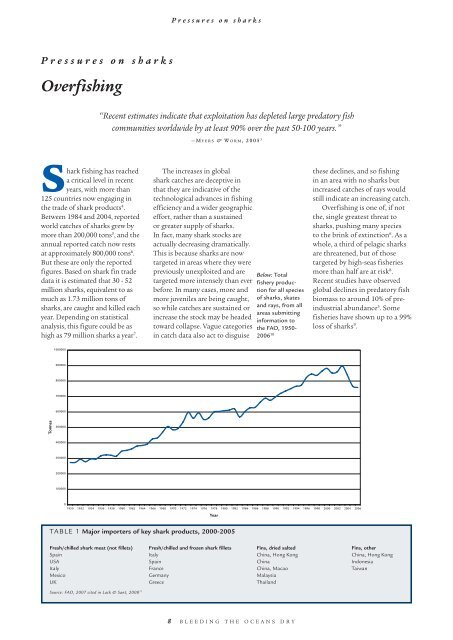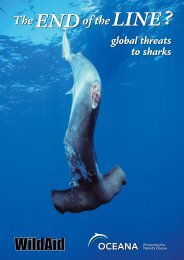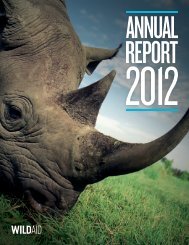Bleeding the Oceans Dry - WildAid
Bleeding the Oceans Dry - WildAid
Bleeding the Oceans Dry - WildAid
- No tags were found...
You also want an ePaper? Increase the reach of your titles
YUMPU automatically turns print PDFs into web optimized ePapers that Google loves.
P r e s s u r e s o n s h a r k sP r e s s u r e s o n s h a r k sOverfishing“Recent estimates indicate that exploitation has depleted large predatory fishcommunities worldwide by at least 90% over <strong>the</strong> past 50-100 years.”— M y e r s & W o r m , 2 0 0 5 3Shark fishing has reacheda critical level in recentyears, with more than125 countries now engaging in<strong>the</strong> trade of shark products 4 .Between 1984 and 2004, reportedworld catches of sharks grew bymore than 200,000 tons 5 , and <strong>the</strong>annual reported catch now restsat approximately 800,000 tons 6 .But <strong>the</strong>se are only <strong>the</strong> reportedfigures. Based on shark fin tradedata it is estimated that 30 - 52million sharks, equivalent to asmuch as 1.73 million tons ofsharks, are caught and killed eachyear. Depending on statisticalanalysis, this figure could be ashigh as 79 million sharks a year 7 .1000000Total Fishery Production for Sharks (ISSCAAP Group)The increases in globalshark catches are deceptive inthat <strong>the</strong>y are indicative of <strong>the</strong>technological advances in fishingefficiency and a wider geographiceffort, ra<strong>the</strong>r than a sustainedor greater supply of sharks.In fact, many shark stocks areactually decreasing dramatically.This is because sharks are nowtargeted in areas where <strong>the</strong>y werepreviously unexploited and aretargeted more intensely than everbefore. In many cases, more andmore juveniles are being caught,so while catches are sustained orincrease <strong>the</strong> stock may be headedtoward collapse. Vague categoriesin catch data also act to disguiseBelow: Totalfishery productionfor all speciesof sharks, skatesand rays, from allareas submittinginformation to<strong>the</strong> FAO, 1950-2006 10<strong>the</strong>se declines, and so fishingin an area with no sharks butincreased catches of rays wouldstill indicate an increasing catch.Overfishing is one of, if not<strong>the</strong>, single greatest threat tosharks, pushing many speciesto <strong>the</strong> brink of extinction 6 . As awhole, a third of pelagic sharksare threatened, but of thosetargeted by high-seas fisheriesmore than half are at risk 8 .Recent studies have observedglobal declines in predatory fishbiomass to around 10% of preindustrialabundance 3 . Somefisheries have shown up to a 99%loss of sharks 9 .900000800000700000600000Tonnes50000040000030000020000010000001950 1952 1954 1956 1958 1960 1962 1964 1966 1968 1970 1972 1974 1976 1978 1980 1982 1984 1986 1988 1990 1992 1994 1996 1998 2000 2002 2004 2006YearTable 1 Major importers of key shark products, 2000-2005Fresh/chilled shark meat (not fillets) Fresh/chilled and frozen shark fillets Fins, dried salted Fins, o<strong>the</strong>rSpain italy China, Hong Kong China, Hong KongUSA Spain China indonesiaItaly France China, Macao taiwanMexico germany malaysiaUK greece thailandSource: FAO, 2007 cited in Lack & Sant, 2008 118 b l e e d i n g t h e o c e a n s d r y





